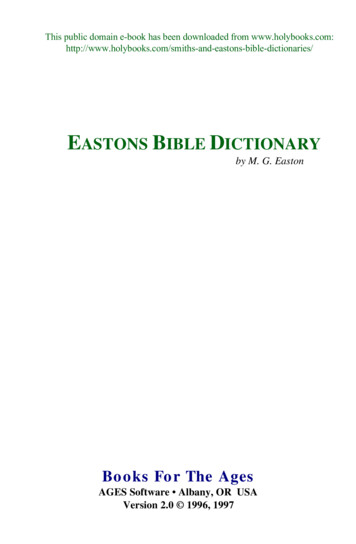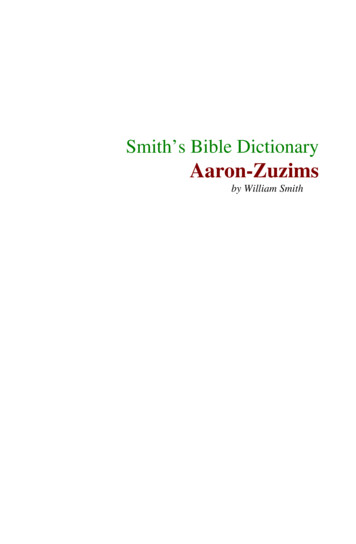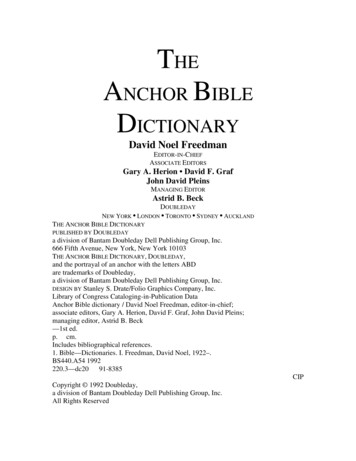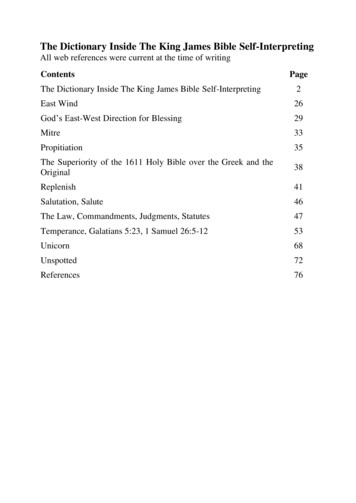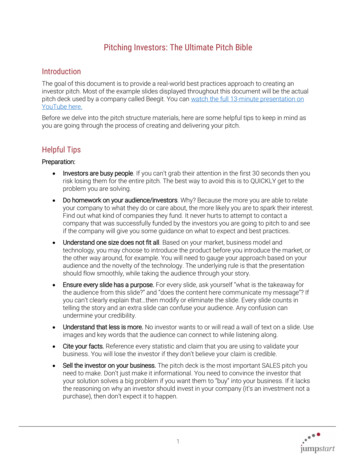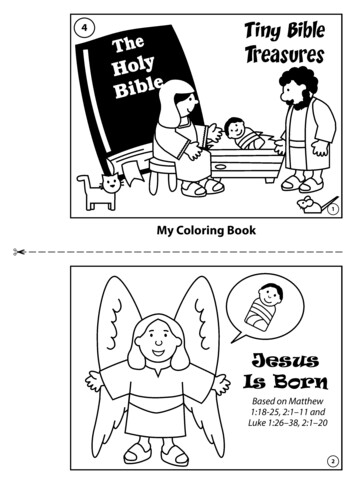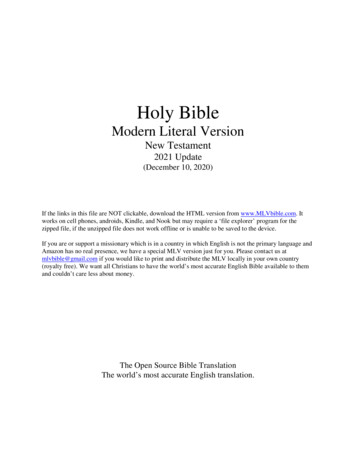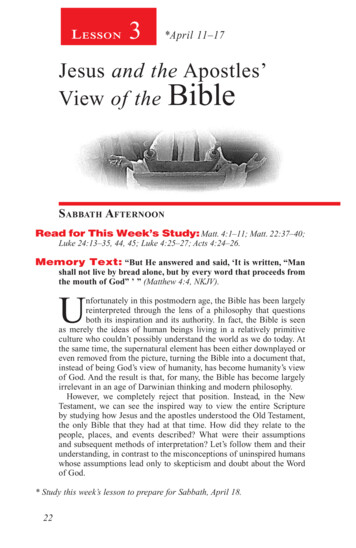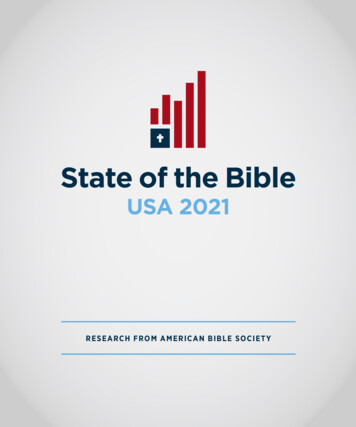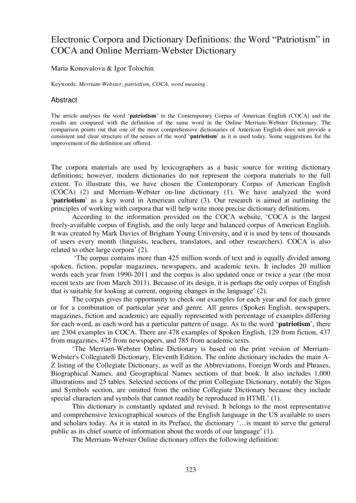
Transcription
VINE’SCOMPLETEEXPOSITORYDICTIONARYOF OLD AND NEWTESTAMENT WORDSW.E. VINE,MERRILL F. UNGER, WILLIAM WHITE, JR.W.E. Vine's “Complete Expository Dictionary of Old& New Testament Words” published in 1940 and without copyright.Vines Expository Dictionaryof theOld TestamentEdited byMerrill F. Unger, Th.M., Th.D., Ph.D.William White, Jr., Th.M., Ph.D.
CONTRIBUTORSGleason ArcherE. Clark CopelandLeonard CoppesLouis GoldbergR. K. HarrisonHorace HummelGeorge KufeldtEugene H. MerrillWalter RoehrsRaymond SurburgWillem van GemerenDonald WoldFOREWORDThe Expository Dictionary of the Old Testament will be a useful tool in the hands of thestudent who has little or no formal training in the Hebrew language. It will open up thetreasures of truth that often lie buried in the original language of the Old Testament,sometimes close to the surface and sometimes deeply imbedded far beneath the surface.The student trained in Hebrew will find the Expository Dictionary to be a handyreference source. But the student without Hebrew training will experience a special thrillin being able to use this study tool in digging out truths from the Hebrew Bible nototherwise accessible to him.It is, of course, possible to be a serious student of the Old Testament without having aknowledge of the Hebrew language. English translations and commentaries are ofinestimable value and have their proper place. but a reference book that opens up thelanguage in which the Scriptures were originally revealed and recorded, and which makesthem available to readers unacquainted with the original tongue, has a value that at oncebecomes apparent.As the language divinely chosen to record the prophecies of Christ, Hebrew possessesadmirable qualities for the task assigned it. The language has a singularly rhythmic andmusical quality. In poetic form, it especially has a noble dignity of style, combined with avividness that makes it an effective vehicle for expression of sacred truth. The ideasbehind its vocabulary give Hebrew a lively, picturesque nature.Most Hebrew words are built upon verbal roots consisting of three consonants calledradicals. There are approximately 1850 such roots in the Old Testament, from whichvarious nouns and other parts of speech have been derived. many of these roots representtheological, moral, and ceremonial concepts that have been obscured by the passage oftime; recent archaeological and linguistic research is shedding new light on many of theseconcepts. Old Testament scholars find that biblical Hebrew can be compared with other
Semitic languages such as Arabic, Assyrian, Ugaritic, Ethiopic, and Aramaic to discoverthe basic meaning of many heretofore obscure terms.But is is not enough merely to have clarified the meaning of each root word. Eachword can take on different shades of meaning as it is employed in various contexts, soone must study the various biblical occurrences of the word to arrive at an accurateunderstanding of its intended use.This type of research has introduced students of Hebrew to a new world ofunderstanding the Old Testament. But how can this material be made available to thosewho do not know Hebrew? That is the purpose of the present work.now the lay student can have before him or her the Hebrew root, or a Hebrew wordbased on that root, and can trace its development to its use in the passage before him.Moreover, he can acquire some appreciation of the richness and variety of the Hebrewvocabulary. For example, Hebrew synonyms often have pivotal doctrinal repercussions,as with the word virgin in Isaiah 7:14, compared with similar words meaning “youngwoman.” In some cases, a play on words is virtually impossible to reflect in the Englishtranslation (e.g., Zeph 2:4–7). Some Hebrew words can have quite different—sometimesexactly opposite—meanings in different contexts; thus the wordcan mean “tobless” or “to curse,”andcan mean “to redeem” or “to pollute.”The lay student, of course, will suffer some disadvantage in not knowing Hebrew. yetis is fair to say that an up-to-date expository dictionary that makes a happy selection ofthe more meaningful Hebrew words of the Old Testament will open up a treasure houseof truth contained in the Hebrew Bible. It can offer a tremendous boon to the meaningfulstudy of Scripture. It cannot fail to become an essential reference work for all seriousstudents of the Bible.MERRILL F. UNGERINTRODUCTIONThe writings of the New Testament are based in a large measure on God’s revelationin the Old Testament. To understand the New Testament themes of Creation, Fall, andRestoration, it is necessary to read of their origin in the Old Testament.The New Testament was written in a popular dialect of an Indo-European language,Greek. The Old Testament was written in the Semitic languages of Hebrew and Aramaic.For centuries, lay students of the Bible have found it very difficult to understand thestructure of biblical Hebrew. Study guides to biblical Hebrew are designed for peoplewho can read Hebrew-and many of them are written in German, which only compoundsthe difficulty.This Expository Dictionary seeks to present about 500 significant terms of the OldTestament for lay readers who are not familiar with Hebrew. It describes the frequency,usage, and meaning of these terms as fully as possible. No source has been ignored inseeking to bring the latest Hebrew scholarship to the student who seeks it. It is hoped that
this small reference book will enlighten Bible students to the riches of God’s truth in theOld Testament.A. The Place of Hebrew in History. Hebrew language and literature hold a uniqueplace in the course of Western civilization. It emerged sometime after 1500 B.C. in thearea of Palestine, along the eastern shore of the Mediterranean Sea. The Jewish peoplehave used Hebrew continuously in one location or another to the present day. Amodernized dialect of Hebrew (with spelling modifications) is the official language of theState of Israel.When Alexander the Great came to power, he united the Greek city-states under theinfluence of Macedonia from about 330 B.C. to 323 B.C. Alexander and his generalsvirtually annihilated the social structures and languages of the ancient societies that theirempire had absorbed. The Babylonians, Aramaeans, Persians, and Egyptians ceased toexist as distinct civilizations; only the Greek (Hellenistic) culture remained. Judaism wasthe only ancient religion and Hebrew the only ancient language that survived thisonslaught.The Hebrew Bible contains the continuous history of civilization from Creation toRoman times. It is the only record of God’s dealings with humanity through His prophets,priests, and kings. In addition, it is the only ancient religious document that has survivedcompletely intact.Hebrew is related to Aramaic, Syriac, and such modern languages as Amharic andArabic (both ancient and modern). It belongs to a group of languages known as theSemitic languages (so called because Scripture says that they were spoken by thedescendants of Noah’s son, Shem). The oldest known Semitic language is Akkadian,which was written in the "wedge-shaped" or cuneiform system of signs. The earliestAkkadian texts were written on clay tablets in about 2400 B.C. Babylonian and Assyrianare later dialects of Akkadian; both influenced the development of Hebrew. Because theAkkadian, Babylonian, and Assyrian languages were all used in Mesopotamia, they areclassified as "East Semitic" languages.The earliest evidence for the origins of "West Semitic" languages appears to be aninscription from the ancient city of Ebla. This was a little-known capital of a Semitic statein what is now Northern Syria. The tablets of Ebla are bilingual, written in both Sumerianand Eblaite. The team of Italian archaeologists excavating Ebla have reported that thesetablets contain a number of personal and place names mentioned in the Book of Genesis.Some of the tablets have been dated as early as 2400 B.C. Since Hebrew was also a WestSemitic language, the publication of Ebla’s texts may cast new light on many olderHebrew words and phrases.The earliest complete series of pre-Hebrew texts comes from the ancient Canaanitecity of Ugarit. Located on a cluster of hills in southern Lebanon, Ugarit has yielded textsthat contain detailed information about the religion, poetry, and trade of the Canaanitepeople. The texts are dated between 1800 and 1200 B.C. These tablets contain manywords and phrases that are almost identical to words found in the Hebrew Bible. TheUgaritic dialect illuminates the development of Old Hebrew (or Paleo-Hebrew). Thepoetic structure of the Ugaritic language is mirrored in many passages of the OldTestament, such as the "Song of Deborah" in Judges 5. The scribes of Ugarit wrote in amodified cuneiform script that was virtually alphabetic; this script prepared the way forusing the simpler Phoenician writing system.
A number of texts from various parts of the Near East contain West Semitic wordsand phrases. The most important of these are the tablets from the ancient Egyptian city ofAmarna. These tablets were written by the petty rulers of the Egyptian colonies of SyriaPalestine and by their overlord, the pharaoh. The tablets from the minor princes werewritten in Babylonian; but when the correspondent’s scribe did not know the properBabylonian word to express a certain idea, he substituted a Canaanite "gloss." Theseglosses tell us much about the words and spellings that were used in Palestine during thetime when Paleo-Hebrew emerged as a distinct language.The Hebrew language probably came into existence during the patriarchal period,about 2000 B.C. The language was reduced to writing in about 1250 B.C., and the earliestextant Hebrew inscription dates from about 1000 B. C. These early inscriptions werecarved on stone; the oldest known Hebrew scrolls were found in the Qumran caves nearthe Dead Sea, and they date from the third century B.C. While some secular Hebrew textshave survived, the primary source for our knowledge of classical Hebrew is the OldTestament itself.B. The Origin of the Hebrew Writing System. Greek tradition claims thatPhoenicians invented the alphabet. Actually, this is only partially true, since thePhoenician writing system was not an alphabet as we know it today. It was a simplifiedsyllabary system-in other words, its various symbols represent syllables rather thanseparate vocal components. The Hebrew writing system grew out of the Phoeniciansystem.The Hebrew writing system gradually changed over the centuries. From 1000 to 200B.C., a rounded script (Old Phoenician style) was used. This script was last used forcopying the biblical text and may be seen in the Dead Sea Scrolls. But after the Jewsreturned from their Babylonian Captivity, they began to use the square script of theAramaic language, which was the official language of the Persian Empire. Jewish scribesadopted the Aramaic book hand, a more precise form of the script. When Jesusmentioned the "jot" and "little" of the Mosaic Law, He was referring to manuscripts inthe square script. The book hand is used in all printed editions of the Hebrew Bible.C. A Concise History of the Hebrew Bible. Undoubtedly the text of the HebrewBible was updated and revised several times in antiquity, and there was more than onetextual tradition. Many archaic words in the Pentateuch suggest that Moses used earlycuneiform documents in compiling his account of history. Scribes of the royal courtunder David and Solomon probably revised the text and updated obscure expressions.Apparently certain historical books, such as First and Second Kings and First and SecondChronicles, represent the official annals of the kingdom. These books represent thehistorical tradition of the priestly class.The message of the prophets was probably written down sometime after the prophetsdelivered their message. There is a variety of writing styles among the prophetic books;and several, such as Amos and Hosea, seem to be closer to colloquial speech.The text of the Old Testament was probably revised again during the time of KingJosiah after the Book of Law was rediscovered (Second Kings 22-27; Second Chronicles24-35). This would have taken place about 620 B.C. The next two centuries, whichbrought the Babylonian Captivity, were the most momentous times in the history ofIsrael. When the Jews began to rebuild Jerusalem under Ezra and Nehemiah in 450 B.C.,their common speech was the Aramaic language of the Persian court. This language
became more popular among the Jews until it displaced Hebrew as the dominantlanguage of Judaism in the Christian era. There is evidence that the Old Testament textwas revised again at that time.After the Greeks came to power under Alexander the Great, the preservation ofHebrew became a political issue; the conservative Jewish parties wanted to retain it. Butthe Jews of the Diaspora-those living outside of Palestine-depended upon versions of thebiblical text in Aramaic (called the Targums) or Greek (called the Septuagint).Both the Targums and Septuagint were translated from Hebrew manuscripts. Therewere substantial differences between these versions, and the Jewish rabbis went to greatefforts to explain these differences.After Jerusalem fell to the armies of the Roman general Titus, Jewish biblicalscholars were scattered throughout the ancient world and the knowledge of Hebrewbegan to decline. From A.D. 200 to nearly A.D. 900, groups of scholars attempted todevise systems of vowel markings (later called points) to aid Jewish readers who nolonger spoke Hebrew. The scholars who did this work are called Masoretes, and theirmarkings are called the Masora. The Masoretic text that they produced represents theconsonants that had been preserved from about 100 B.C. (as proven by the Dead Seascrolls); but the vowel markings reflect the understanding of the Hebrew language inabout A.D. 300. The Masoretic text dominated Old Testament studies in the MiddleAges, and
Some Hebrew words can have quite different—sometimes exactly opposite—meanings in different contexts; thus the word can mean “to bless” or “to curse,”and can mean “to redeem” or “to pollute.” The lay student, of course, will suffer some disadvantage in not knowing Hebrew. yet is is fair to say that an up-to-date expository dictionary that makes a happy selection of the more .

